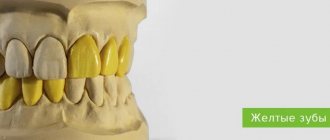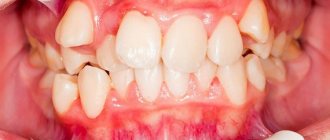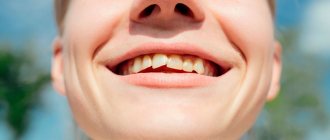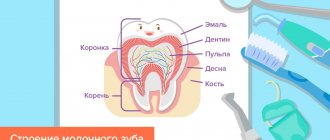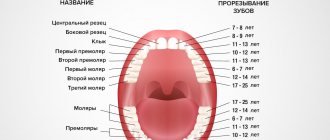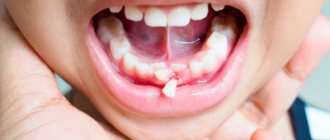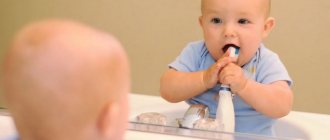The first signs of yellow teeth may appear in a child with the appearance of the first molar. At this stage, parents should be careful and seek advice from a pediatric dentist. If you exclude all factors that influence the darkening of tooth enamel, then it is quite possible that you will be able to correct the natural tone of the tooth enamel of growing teeth. These are the factors.
- Insufficient oral hygiene. If you don't supervise your baby and brush twice a day daily, plaque buildup can negatively impact the shade and formation of your baby's yellow molars.
- Correction of baby food. If a child consumes large quantities of coloring juices (carrots, pomegranates, cherries), pigment may be deposited on the hard tissue of the teeth. If the tint does not disappear within a day, then it is better to exclude such “natural” juices from your baby’s diet. The consumption of sweet and flour products is also important. It is sometimes difficult for a child to refuse sweets, but consuming sweets too often can directly affect the color of tooth enamel. Carbohydrates are a breeding ground for pathogenic bacteria, which produce acids during their life. It is these acids that destroy tooth enamel.
- Taking tetracycline antibacterial drugs. Certain medications can affect the color of enamel. This applies to both the use of medications by the baby himself and the use of medications by the mother during pregnancy. If the first signs of darkening appear during treatment of a child, you should consult a doctor and, possibly, replace the drug with another group of antibiotics.
- Enamel hypoplasia. Only the thin coating of the crown—tooth enamel—has a milky white color. Beneath it are darker tooth tissues - the so-called dentin. It is the translucency of dentin that causes the yellowish or bluish tint. If the enamel layer is insufficient, which sometimes happens in children as a pathology, then the dentin shows through quite strongly, and the teeth acquire a dirty yellow tint. It is not always possible to eliminate this fact. The dentist may prescribe an additional calcium supplement for your baby to support the development of tooth enamel. However, this is not a radical measure, so it is worth waiting until the child’s dentition is fully formed and then choosing a correction method.
- Poor quality drinking water. Large amounts of iron in water can cause yellowing of the enamel. If this situation occurs among all residents of a given region, then special purification filters for drinking water should be purchased. Otherwise, your child will have to put up with yellow teeth.
- Changes in enamel color while wearing braces. Correcting a child’s bite is a necessary and very important event. However, enhanced hygiene should be especially carefully monitored during this period. Plaque forms in the places where the braces are attached, which cannot be cleaned with a regular toothbrush and can form a yellow stain on a child’s tooth. This can lead to darkening of the enamel or even the development of dental caries. You can cope with this problem using a special irrigator designed for cleaning teeth in hard-to-reach places. Or you can visit a dentist and have your mouth professionally cleaned.
- In rare cases, yellowing of teeth can be a consequence of a general illness in the child's body. Diagnoses such as hepatitis, fluorosis, kidney disease, and serious metabolic disorders can provoke changes in the structure of the hard tissues of the teeth. In this case, the question is more about treating the root cause than its consequences.
Is yellowness normal or pathological?
Not every yellowness should be perceived as a deviation from the norm. Sometimes, due to hereditary factors, a child’s enamel becomes more transparent than that of other children. The lack of white pigment causes the dentin to show through, resulting in darker teeth.
Some dentists are inclined to believe that it is better not to correct or whiten such enamel. At least until the child reaches adulthood and hard tissues are fully formed.
If yellow teeth are showing signs of health, the best thing you can do for your baby is to practice good oral hygiene and good nutrition.
How to prevent yellowing of teeth: preventive measures
To avoid the question of how to get rid of yellow plaque, it is better to prevent the problem. As already mentioned, you should give up smoking, carbonated drinks, and coffee. Drinks containing coloring pigments are best consumed through a straw. It is important to neutralize the effect of acids on enamel. To do this, after eating acid-containing foods, you need to rinse your mouth with clean water or drink it or milk. You should also avoid snacking between main meals. This promotes more effective leaching of acids with saliva.
Regular teeth cleaning is one of the main conditions for maintaining a beautiful smile. It is necessary to use dental floss and mouthwash. If you experience dry mouth, you should consult your doctor. Fluoride-containing drugs are taken under strict control.
Rules for children's dental hygiene
The first oral hygiene procedures begin after the baby has cut his first tooth. During this period, the brush is not yet used, and the gums are wiped with a damp cloth. When several teeth erupt, you can begin hygiene with the help of a special baby brush. It should be very soft and delicately clean the delicate surface of children's teeth. When a child reaches 2.5 years of age, he is taught to practice brushing independently, at first without toothpaste. When the baby masters this procedure, you can use special baby pastes, which are designed for the fact that the baby has not yet learned to spit out the paste and will periodically swallow it. Children's pastes should be free of dyes, flavorings and fragrances.
Causes of yellow teeth
Experts note that a child’s body, which is just beginning to function normally, is influenced by many negative external factors. Together they can lead to various disorders. Dentists identify a number of reasons why yellow plaque may form on a child’s teeth, namely:
- improper diet;
- drug treatment;
- insufficient hygiene;
- internal diseases;
- congenital problems;
- heredity.
If we talk about food, then the diet of both an adult and a child should be balanced. Of course, you cannot deprive your child of tasty but not very healthy foods, for example, sweets. But, nevertheless, fruits and vegetables, including raw ones, should prevail in the children's diet. In addition to the fact that they are rich in vitamins and minerals vital for the healthy and full development of the body, they also mechanically clean teeth of various plaque.
The less dyes, chemicals and sugar in food, the healthier and safer it is for the child. The more food is processed and far from its original state (convenience foods, sausages, sweets, flour products), the worse it affects teeth and gums.
Some antibiotics and other medications can stain teeth. Long-term use of medications carries the risk that the enamel may turn yellow. As a rule, after completing the course of treatment, the body cleans the teeth on its own. And after some time, the baby’s smile is snow-white again.
The next reason why yellow spots may appear on the teeth of a one-year-old child and older is improper oral hygiene. If you neglect it, a soft plaque may form on your baby’s teeth. It is this that gives the yellowish tint. In addition, it is a beneficial environment for the proliferation of various bacteria, which can lead to caries and other extremely unpleasant problems in the oral cavity.
If a child is not accustomed to brushing their teeth thoroughly and regularly, this will cause many problems in the future. One of the most important tasks of parents is to instill in their child the habit of constant care of their own oral cavity. The baby should be able to brush his teeth, know when to do it, and be familiar with the basic rules of oral hygiene from early childhood! And parents should unobtrusively control the process of brushing their teeth - perform this hygienic procedure together; make a habit of smiling after brushing your teeth to see if the baby has coped with the task assigned to him, etc.
Often yellowing of teeth signals internal problems in the body. For example, about problems with metabolism, disorders of the gastrointestinal tract or thyroid gland. If your teeth suddenly turn yellow, and this is not due to taking medications or poor nutrition, consult a doctor. He will identify the cause of yellowing of the enamel.
Often the reasons why a child’s chewing teeth or incisors are yellow are congenital. If you or your relatives have yellow tooth enamel, and this is not associated with disease or poor hygiene, the color may be hereditary.
Your baby’s teeth may turn yellow if, during pregnancy, the mother:
- pathologies developed;
- there were infectious diseases;
- severe manifestations of toxicosis were observed;
- had an unbalanced diet.
In addition, factors such as:
- prematurity of the baby;
- conflict of Rh factors of mother and child during pregnancy;
- birth injuries;
- hemolytic pathologies.
If the body's formation of enamel or dentin (the layer of teeth that is under the enamel and has a yellowish tint) is disrupted for any reason, this will likely lead to staining of baby and even permanent teeth. This can happen if for some reason the layer of enamel on the teeth is too thin, “transparent”.
Whitening pastes
Such pastes and gels can be freely purchased in pharmacies, or ordered on the recommendation of your doctor. It is not advisable to use them constantly, since they still have some effect on the enamel. It is best to periodically alternate whitening compounds with medicinal or gum strengthening ones.
With your dentist's approval, you can try home whitening using trays and whitening gels. Such procedures can significantly change the tone of tooth enamel towards white. However, you should not get carried away with this method, since it increases tooth sensitivity and, if used incorrectly, can damage tooth enamel.
Is it possible to whiten teeth at home?
Many people often put off visiting the dentist and try to figure out how to remove yellow discoloration on their own. Often advertised and popular whitening pastes come into view today. But it is worth understanding one important point - they contain particles that act on the tooth surface like sandpaper. Mention this. Over time, such pastes damage the enamel, just like those containing activated carbon. Whitening strips sold in pharmacies also have an aggressive composition and do not have the expected effect.
You should not use baking soda and citric acid for whitening purposes - they simply corrode the enamel. What to do to avoid harming your teeth? The best thing to do at home is to practice regular and careful oral hygiene. It is also necessary to exclude from the diet or limit the amount of “bad” foods and drinks consumed and, of course, quit smoking.
Special diet
It is believed that apples and raw carrots are the best teeth cleaners. These products perfectly remove plaque and supply a huge amount of useful substances to the body. Therefore, you should not limit yourself to them.
The LeaderStom network of clinics offers the services of the best pediatric dentists in Moscow. If you seek professional help in time, the condition of your child’s teeth can be correctly corrected with a course of treatment or preventive measures. Experienced therapists and orthopedists will help eliminate pathological yellowness of teeth and straighten your baby’s bite if indicated. Contact us, we are always ready to help.
Causes of enamel hypoplasia
| Stains on a child’s permanent teeth provoke: | Stains on primary teeth occur due to: |
|
|
How to eliminate yellow teeth[1]
To prevent unhealthy yellow teeth, you need to:
- regular and proper care;
- rejection of bad habits;
- eating calcium-rich foods;
- control over the composition and quality of drinking water.
There are toothpastes for home use that can both remove yellow plaque and lighten the natural tone of the enamel. However, many of them contain harsh abrasive components that are harmful to teeth, so you should choose safe, innovative products with a gentle cleansing formula. These toothpastes lighten teeth when used regularly. If you want an immediate effect, you can use an optical whitening paste.
If these measures do not lead to lasting results, you should additionally consult with your dentist. Cleaning and professional whitening procedures are possible only after complete sanitation of the oral cavity.
It should be noted that even ordinary professional cleaning brightens teeth by 1-2 tones by removing plaque, deposited pigments and tartar. It is carried out using manual, ultrasonic and other methods, and at the end the teeth are polished with special pastes to remove roughness. The result lasts about six months.
If you need to significantly lighten your teeth, you can bleach . The procedure involves applying a special composition to the teeth, usually based on hydrogen peroxide. For this purpose, brushes, applicators or mouth guards (standard or custom-made) can be used. Further, depending on the technique chosen by the doctor, the composition is kept on the teeth in its original state (simple chemical whitening) or activated using high-energy light sources. In both cases, the effect on the teeth lasts no more than 20 minutes. The table provides summary data on the most common methods of professional whitening [1].
| Peroxide content in whitening composition | Light exposure | Lightening degree | Harm to teeth | Price | |
| Chemical bleaching | High | Absent | 5-7 tones | Strong | Low |
| Photobleaching | Average | Average | 8-10 tones | Average | Average |
| Laser whitening | Low | Intensive | 10-12 tones | Weak | High |
The effect of the procedure can last for several years, but it has a number of contraindications and side effects.
Side effects of professional teeth whitening
In large cities of the Russian Federation, about 80% of dental clinics offer whitening procedures [5]. The patient's aesthetic preferences are considered sufficient indications. However, the safety of these procedures is still questionable. Clear contraindications are [4]:
- childhood and adolescence;
- pregnancy;
- presence of dentures;
- untreated diseases of teeth and gums;
- presence of milk teeth;
- oncological and cardiac pathologies.
Whitening is carried out with the participation of aggressive substances, from which the gums and oral mucosa must be protected. One of the most common side effects is increased tooth sensitivity. If whitening has been carried out, special restorative toothpastes .
Dentists advise having your teeth professionally cleaned every six months, as it heals your teeth and returns them to their natural color without damaging the enamel. In addition to it, you can use Colgate® Safe Whitening toothpaste, which does not contain harsh abrasive elements.
List of sources
1. Boltromyuk G.I. Discoloration of teeth. / Toolkit. – Irkutsk: IrGUPS MK ZhT, 2016 – 21 p. // URL: https://www.irgups.ru/sites/default/files/mkzht/mu_diskolorit_zubov_pm.01.pdf (accessed April 25, 2020).
2. Evteev S. S., Lebedeva S. N., Kharitonova T. L. Etiological factors of dental discoloration. // Bulletin of medical Internet conferences, 2022 // URL: https://cyberleninka.ru/article/n/etiologicheskie-faktory-diskoloritov-zubov (access date 04/25/2020).
3. Lack or excess of fluoride // WHO International Program on Chemical Safety, Impact of chemicals on health // URL: https://www.who.int/ipcs/assessment/public_health/fluoride/ru/ (accessed 04/25/2020 G.).
4. Asatryan N. S. Teeth whitening methods. Indications and contraindications. Optimization of the choice of whitening method for patients with different clinical situations. // Bulletin of medical Internet conferences, 2022 // URL: https://cyberleninka.ru/article/n/metody-otbelivaniya-zubov-pokazaniya-i-protivopokazaniya-optimizatsiya-vybora-metoda-otbelivaniya-patsientam-s -razlichnoy/viewer (accessed April 25, 2020).
5. Belenova I. A., Sushchenko A. V., Kudryavtsev O. A., Koretskaya I. V., Rozhkova E. N. Prevention of complications after professional teeth whitening // Bulletin of medical technologies, electronic edition, 2022. // URL: https://cyberleninka.ru/article/n/profilaktika-oslozhneniy-posle-professionalnogo-osvetleniya-zubov (date accessed 04/28/2020).
The nature of the formation of yellow plaque
What is yellow plaque? Essentially, these are remnants of food, bacteria and dead mucosal cells. All this accumulates on the teeth throughout the night/day, which is why brushing your teeth in the morning and before bed is a must. At the same time, plaque itself is not a diagnosis, but can provoke the development of various diseases. People around you will immediately notice if children's baby teeth lose their snow-white color.
Yellow plaque on a child's teeth
Yellowing of teeth is usually associated with poor hygiene. If you do not take proper care of your teeth, plaque and tartar will begin to form, which can eventually lead to tooth decay. If children's teeth are in this condition, this provokes the development of various pathologies and diseases, including caries, gingivitis, and periodontitis. Also, as plaque grows, the likelihood of developing diseases of the ENT organs and oral cavity increases.
Child 1 year old, yellow plaque on teeth
Preventive measures
To avoid the appearance of yellow plaque on your child’s teeth, you need to follow a few simple rules.
- First of all, the child must follow a balanced diet.
- Brushing your teeth (even newly erupted ones) should be done at least twice a day.
- It is also important to visit your dentist regularly.
- Finally, fluoride toothpaste should be used to brush your teeth.
The effectiveness of fluoride toothpastes
Parodontax Fluoride Toothpaste for Daily Use
You should avoid drinking soda and packaged juices. The same goes for drug abuse. The diet should include fresh vegetables and fruits - this will help keep the child’s teeth snow-white.
Plaque in children over 7 years of age
At school age, yellowing of teeth in almost all cases is associated with improper brushing. It is important to choose a good brush for your child, taking into account the degree of sensitivity of the gums. To avoid yellowing of the enamel, no special care is required, but to correct the advanced situation, the help of a dentist will be required.
Snow-white teeth, a Hollywood smile - none of this is given for nothing. It is necessary to brush your teeth and follow certain rules
On a note! The formation of yellow plaque occurs gradually. First, bad breath appears, then a slippery coating consisting of bacteria and food debris appears. If you do not brush your teeth in a timely manner, the soft plaque, without being removed, will mineralize and become real tartar.
Most plaque appears on the molars. Soft foods (refined/carbohydrates) end up in hard-to-reach places and are not easy to clean out. This is why children are advised to regularly eat solid vegetables/fruits - for example, carrots, apples, etc. - as they literally clean off plaque, preventing the formation of yellow spots.
Stages of caries
More rare causes of yellowing include a tendency to allergic reactions and metabolic disorders. Because of all this, the water-salt balance and pH of saliva are disrupted, and this, in turn, leads to the proliferation of bacteria in the oral cavity.
- Frequent urination or why do I pee so often?

